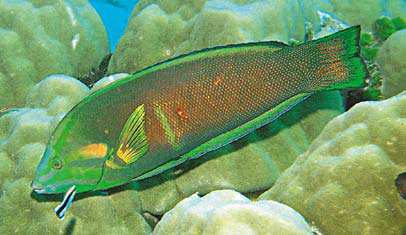| LABRIDAE |

Coris cuvieri
(photo by Ukkrit Satapoomin)
|
Coris cuvieri (Bennett, 1831) African Coris |
|
D IX, 12; A III, 12; P1 13; LLp 71-84; GR 16-20. Body moderately slender. Dorsal profile of head convex; jaws prominent with 2 strong canines situated anteriorly in each jaw, following teeth slightly smaller; 1 or 2 separate canines on each side at rear of upper jaw. First two dorsal spines of adults flexible, close together, and elongate. Predorsal scales extending anteriorly to above eye; no scales on cheek and opercle. Lateral line complete. Caudal fin rounded, pelvic fins long. Color: adults reddish brown with green bands on head and small green spots (one per scale) on body; males with a pale green bar on body above origin of anal fin. Juveniles orange-red with 3 blackedged white spots dorsally on body, the first two extending onto dorsal fin; head with 2 similar but smaller middorsal spots. Size: maximum length about 38 cm. Distribution: Indian Ocean, from East Africa and Red Sea to Andaman Sea. Remarks: feeds on hard-shelled invertebrates; turns over rocks to prey upon the invertebrates hiding beneath. |
|
|